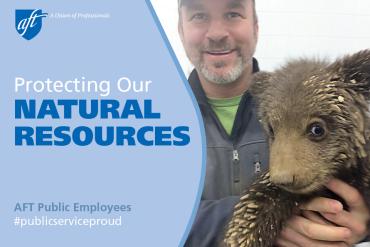Alaskans who live in the seven villages on Kodiak Island are a tight-knit bunch who rely on the island's wildlife and fisheries to sustain themselves. Making sure the wildlife stays healthy is the work of AFT member and wildlife biologist Nate Svoboda.
Tagging mountain goats, taking hair and blood samples from bears, performing ultrasounds and administering antibiotics are just a few of the duties Svoboda is responsible for, as he and fellow employees monitor the health of wildlife on Kodiak Island, part of the 5,000-square mile Kodiak archipelago that makes up their territory. The bear cub Svoboda is holding below is one of three cubs he rescued about a year ago after a hunter accidentally killed their mother. Each cub now weighs almost 600 pounds.
A member of the Alaska Public Employees Association/AFT, Svoboda says what he likes best about his job is engaging with the Kodiak community, meeting people who visit from all over the world, and working outdoors.
One of his biggest concerns on the job is climate change. Kodiak is an ecosystem in which there are few species and many of the island's animals live on fish or other marine-dependent resources. The temperatures Alaska has been experiencing over the past few decades seem to be harming fish and other animals as well. For example, biologists and researchers have seen an unprecedented number of marine birds (called the common murre) die from starvation over the past two years. Although no long-term data are available, the scientists speculate that warming ocean temperatures have reduced the number of phytoplankton, which fish eat, decimating the fish and starving the birds that eat the fish. Warmer temperatures also seem to be affecting mountain goats and other high-altitude mammals that thrive in cooler environments.
"Fisheries are just as important as wildlife because they rely on each other," Svoboda says.
He feels like the APEA/AFT has his back in a job that literally covers a lot of ground and can leave a worker feeling isolated.
"I appreciate the support we get from our union, and it makes me feel that we have someone backing us. It's comforting," says the native Nebraskan who's worked in Alaska's fish and game service for about five years and as a biologist for 17 years. "I appreciate that our union will go to bat for us for healthcare and environmental concerns. I feel like our voices are heard."
During Public Service Recognition Week, May 7-13, the AFT honors the 8,000 workers represented by APEA, as well as all those who serve their communities nationwide, including public safety officers, transportation and highway workers, judicial employees, social workers, vocational educators and the myriad other professionals who make up AFT Public Employees.
[Annette Licitra]

